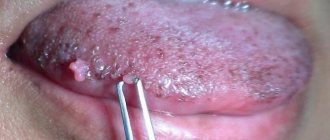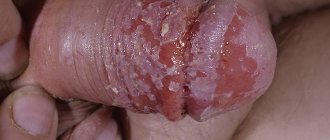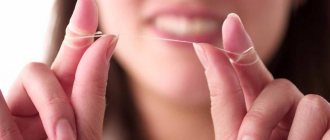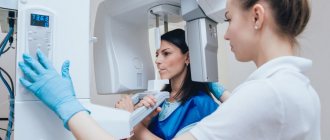ATTENTION! From January 2022, a new medical center will open for you at the address: Dmitrovskoye Shosse, 81 (5 minutes walk from the Selegerskaya metro station), where you can receive a wide range of medical services, including CT (computer tomography).
- home
- Urology Clinic
- Surgical urology
- Removal of condylomas in men
Condylomas (genital warts) are a type of viral wart, which is a papillary growth on the skin or mucous membrane. Genital warts in men are localized in the intimate area and often go unnoticed. The height above the skin is 0.2 cm, externally they have a flesh-colored or grayish color. Benign formations of small size, which are found on the penis, scrotum and around the anus.
Treatment of condylomas in men should begin immediately after detection. We invite you to make an appointment with urologists. We guarantee complete confidentiality. Doctors specialize in the treatment of viral infections of the intimate areas. KDS Clinic performs removal of condylomas in men using the Surgitron device.
Symptoms of condylomas
Single neoplasms are difficult to detect and there is no pain syndrome. Condylomas do not bother the patient and do not affect the quality of sexual life. Formations are detected by touch or upon examination.
Papillomas in the urethra in men, around the head of the penis, around the anus and on the scrotum are common places for growths to occur. HPV is found in warm, moist places, so the folds of the genitals and anus are likely places where growths are found.
If the disease is not treated, it will progress, eventually the papillomas will grow together, protrude more above the surface of the skin, and the appearance will resemble cauliflower.
Fused papillomas affect a large area on the genitals, and then the symptoms of the disease become obvious:
- Pain during sexual intercourse. Growths on the head of the penis interfere with penetration and cause discomfort to partners.
- Itching, redness of the affected area, irritation. During friction, the growths become injured, bleed and itch.
- Difficulty urinating. Those papillomas that have grown in the urethra will interfere with normal urination.
If a man develops condylomas on the head of the penis, this is the first sign that the human papillomavirus (HPV) has entered the body.
You can get infected in several ways:
- sexual intercourse – this includes vaginal, oral or anal intercourse. When healthy mucous membranes come into contact with infected genitals, infection occurs;
- at home, 20% of those infected caught the virus due to insufficient hand hygiene, sharing personal hygiene items (washcloth, toilet rim, underwear, towels);
The absence of tumors on a man’s genitals does not mean that the person has not become a carrier of the HPV virus. If a person has a strong immune system and leads a healthy lifestyle, the body resists the virus, stopping the progression of the disease.
Decreased immunity often causes growths to appear. There are factors that negatively affect the body's immune system:
- recurrent colds;
- hypothermia;
- unbalanced, meager, monotonous nutrition;
- regular neuroses, stress, overwork, lack of sleep;
- smoking and alcohol abuse;
Doctors recommend regular examinations to ensure the absence of the virus, and that the man’s sexual partner also be examined.
Removal of condylomas from the foreskin and glans penis
HPV today is an incurable disease, because there is no medicine that would destroy the virus itself, but relapses are successfully removed. The sooner treatment is started, the greater the chances of getting rid of condylomas.
Treatment methods are divided into surgical and conservative. The latter include:
- Immunotherapy to enhance immunity
. It should be noted that immunostimulants should be taken carefully and only after consultation with a doctor, because they contribute to the development of oncology. Those. If you already have cancer, it will only get worse! Immunomodulators used in the treatment of HPV are of two types: based on interferon-alpha-2 (Altevir, Intron-A, Realdiron) and stimulators of interferon protein production by microphages and lymphocytes (Cycloferon, Arbidol, Amiksin). - The use of ointments that stop the proliferation of condylomas
(Oxolin, Viferon, Aldara cream, Panavir gel, Epigen cream). They are applied to the affected areas of the skin, stopping the further spread of atypical cells, healing tissues and increasing the intracellular production of interferons. - Immunostimulants and ointments
are used as a general course for several months in the initial stages of the disease. Their use is effective only for single small-sized condylomas.
Preparing for treatment
Before starting treatment for papilloma, the doctor conducts a thorough examination of the man’s groin under magnification, makes a diagnosis, and studies tests.
The effectiveness of treatment depends on the correct diagnosis:
- Oral interview with a venereologist, taking an anamnesis.
- If the head of the penis, urethra or urethra is affected, consultation with a urologist is indicated.
- You need to be tested for HPV using the PCR method (scraping from the genitals), for AIDS, HIV and syphilis.
- Examination of the anus by a proctologist.
- Getting tested for STDs.
After all the tests are ready, the doctor will select the appropriate method for treating and removing papillomas for the man. Tumors can be removed only if the man does not have infectious or viral diseases in the acute stage.
Features of neoplasms on the genital organs
To prescribe the most effective treatment, papillomas must be distinguished from other neoplasms on the skin of the groin area: enlarged lymph nodes, manifestations of molluscum contagiosum and the herpes virus, abscesses in the infiltration stage, tumors and inguinal hernias. Only a specialist can accurately determine the nature of neoplasms on the genital organs. Any papillomas are a source of secondary self-infection: the virus can grow locally and spread throughout the body, causing the appearance of new formations on the skin and mucous membranes.
Treatment of papilloma virus in men
If a man has condylomas on the head of the penis, treatment is carried out in two directions:
- Remove growths.
- Conduct shock antiviral therapy.
None of them have any advantages, since the doctor prescribes treatment based on their examination data and the tests obtained. Often these treatments are complementary to each other.
Drug therapy complements the process of removing papillomas in men. With its help, the immune system is strengthened to avoid relapse, since removal of papillomas again brings the patient to the doctor with the same symptoms of the disease in 30% of cases.
The patient is prescribed immunostimulants: polyoxidonium, immunal, cycloferon, etc. These drugs are prescribed only by a therapist or urologist.
Why are genital warts dangerous for men?
The appearance of condylomas is caused by HPV strains No. 6, 11, 16, 18, 30, 42-45, 51, 52 and 53, accounting for about 2% of all types of papillomavirus. Moreover, it is these strains that are oncogenic and cause cancer in more than half of the cases. The most dangerous of them are types 6, 11 (to a lesser extent), 16 and 18.
In addition to oncology, condylomas cause other troubles:
- Psychological trauma
. Men are embarrassed by sexual diseases and are afraid of injuring tumors, so they restrain sexual activity. - Infection
. Condylomas come into contact with underwear, causing injury, and the same thing happens during washing. The infection easily penetrates the wounds, leading to inflammation. - Inflammation of the prostate
. Decreased sexual function leads to stagnation of secretions in the prostate and prostatitis.
Other complications are possible and are described below.
Important
If papillomas appear on the head of a man’s penis, then curing them will not be easy, and the removal procedure will be painful.
First of all, doctors recommend that a man avoid promiscuous sex and use barrier contraception.
With early prevention and a negative test for the virus, a healthy man is offered vaccination against HPV. If the virus is detected, but papillomas have not yet had time to manifest themselves, it is advised to strengthen the immune system in order to avoid their growth.
There are several ways to strengthen your immune system:
- Improve your diet, add a vitamin-mineral complex or foods enriched with beneficial microelements and substances.
- Exercise.
In winter and in the off-season, immunologists advise strengthening the immune system with vitamin complexes and antiviral drugs.
How to remove condylomas of the penis and foreskin
Surgical methods for eliminating condylomas include:
- Electrocoagulation.
An effective, inexpensive, but painful method. It involves applying an electric current to the condyloma, causing it to fall off, leaving a small scar. The method is already outdated. - Cauterization with a solution of acetic and nitric acid
. As a result, the condyloma tissue dies, and it dries out and falls off. Used on separately located large condylomas. The method is not recommended, as surrounding healthy tissue may be damaged, and healing on the penis will take a long time. - Cryodestruction
. This is the effect of ultra-low temperatures of liquid nitrogen on an atypical area, as a result of which condyloma cells change structure and self-destruct. This is a painless method that does not leave scars. But it is effective for small, separately located condylomas. - Laser removal
. The method is painful and requires local anesthesia. Depending on the size of the condyloma, the doctor selects the depth of exposure of the laser beam. It burns out the base of the condyloma, it is deprived of nutrition and falls off, leaving no scar. - Surgical removal
with a metal, argon, plasma scalpel. Used to remove large condylomas located in groups. Requires stitches and long healing. - Radio wave method
. The most modern, effective and painless method. With the help of radio waves of various frequencies, the condyloma is completely excised and disappears. The nearby healthy tissues remain intact, and the patient is left with no scars. The relatively high cost of the method (from 500 rubles per tumor) is dictated by the high cost of complex professional equipment.
Urologists
Erkov Igor Viktorovich Urologist andrologist
Cost of admission 2500
₽
Make an appointment
Fomenko Alexander Pavlovich Urologist andrologist
Cost of admission 2500
₽
Make an appointment
Diagnosis of pearly papules
The diagnosis is made based on a clinical examination by a urologist or dermatovenerologist. If the change is accompanied by symptoms of inflammation - redness, swelling and itching - another etiology should be considered.
They are often confused with condylomas (genital warts), which are sexually transmitted diseases caused by HPV infection. The misconception can be easily eliminated with the help of a biopsy and microscopic examination of this change - a different number of dilated thin-walled blood vessels, proliferation of fibroblast cells and connective tissue are observed.
Rehabilitation after frenulotomy
After frenulotomy, the patient rests for several hours in the ward, then he is sent home. After 2-3 days you can go to work, if it does not involve lifting heavy loads (the seam may come apart).
There is usually some slight swelling or bruising in the first 24 hours, which goes away within a few hours. Within two days, a few drops of blood may come out of the suture. This is fine. They need to be blotted with a sterile napkin and observed over the wound.
Antibacterial therapy is usually not required. The course of antibiotics is replaced by antiseptic ointment "Levomekol". A thin layer of it is applied to the suture area once a day for 5 days. You must appear for a dressing change the next day, and for a final examination after 10 days. The pain goes away completely after 2 weeks. During an erection, slight discomfort may remain for 3-4 weeks.
During the rehabilitation period, the patient should adhere to the following recommendations of the attending physician:
- carry out hygiene measures after each visit to the toilet and use an antiseptic solution prescribed by a doctor for this;
- take a course of antibiotics to prevent the development of purulent infections;
- during rapid healing, do not use fat-based ointments, as they can prolong the rehabilitation period;
- visit a urologist a week after the operation so that he can determine the need to remove the remaining threads, which should be completely resolved by this time.
In addition, during the recovery period you should avoid:
- physical activity and sports;
- visits to baths, saunas, swimming pools;
- taking baths; sexual intercourse and masturbation.
- The latter is necessary in order to eliminate the risk of seams coming apart.
Pearly papillomas on the head
Some patients confuse pearly papules (another name is pearly) with papillomas on the head.
But these formations are completely different in origin.
Moreover, pearlescent papules are not even considered a pathological process.
These formations often appear in young men.
They border the head in a circle.
They are small in size, always multiple, more or less identical.
Like papillomas, these formations are painless.
But they do not carry any risks, are not complicated and do not require removal for medical reasons.
Such papules can only be removed to improve the aesthetics of the penis.
Types of papillomas on the head
Single or multiple growths form on the head or frenulum.
Most often they have the form of finger-like protrusions.
Color pink or red.
In most patients, papillomas do not hurt or itch, do not swell and do not cause subjective sensations.
They simply exist, and this very fact causes discomfort.
The main types of condylomas under the head:
- genital warts;
- papules;
- spots;
- bowenoid papulosis;
- Bowen's disease;
- giant Buschke-Levenshtein condyloma.
Usually the formations appear as protrusions, papules or spots.
In the latter case, they can be difficult to detect due to the lack of relief.
Only the color of the skin changes.
All papillomas on the head are well vascularized.
You can see many blood vessels in them.
The most dangerous form of the disease is giant condyloma.
Although histological studies show that there are no signs of malignancy, it behaves exactly like a malignant tumor.
This condyloma does not metastasize.
But it is characterized by destructive growth with destruction of surrounding tissues.
After removal it often recurs.
The tumor has no clear boundaries.
It reaches enormous sizes during the natural clinical course of the disease.
Quite often, giant condyloma causes death.
How to get rid of genital papillomas?
Despite the scale of research and understanding of the problem by the medical scientific community, it has not been possible to develop specific drugs for the treatment of HPV, as already mentioned. Some countries offer vaccination against the virus at an early age. However, high positive results cannot be achieved with this measure. After all, the vaccine is effective for a fairly short time, but the risk of infection is present throughout life.
Important: The HPV vaccine can only protect up to a certain point. For example, young people who have not reached puberty and have no history of sexual contact are offered to use this type of protection against the virus. After all, it is during adolescence, when the first sexual experience is acquired, that the greatest change of sexual partners is noted, weakened immunity is diagnosed, and infection most often occurs.
But if you couldn’t protect yourself from the virus, you can fight it. An integrated approach to treatment includes:
- measures to strengthen the immune system, because the body’s internal defenses can suppress the activity of the virus;
- taking antiviral drugs that chemically inhibit the spread of the virus;
- removal of papillomas on the genitals, oral cavity and other parts of the body.
Important: If HPV is detected in one partner in a couple, treatment is carried out on both of them, because the risk that both are infected is more than 80%. An adequate, gentle treatment program is developed for an individual patient or couple, taking into account the manifestations of the disease and the type of virus identified through laboratory tests.
There is a chance of self-healing, but it is quite low. And not in a couple where there will be constant relapses. At the same time, a well-chosen treatment tactic by a doctor allows you to get rid of the pathology quite quickly.
Important: It is strictly not recommended to remove papillomas at home, since the use of aggressive media based on vinegar and iodine is dangerous to health. An extensive tissue burn may form at the site of exposure. In this case, self-medication will not bring the desired result. After all, the skin tumor must be removed completely “at the root.” Only in this case it will not grow again.
Do not try to remove warts at home or in a beauty salon. Such treatment does not provide a complete picture of a person’s health status. The type of virus is not determined, and antiviral therapy is not carried out. This means that the symptoms are only muted, and the problem gets worse.
Medical methods for treating genital and other types of papillomas are:
- Radio wave method.
- Laser method.
- Use of liquid nitrogen.
The best of them today is burning out tumors with a laser. A safe, bloodless and painless method has virtually no contraindications. One or two warts are removed in 5 minutes. Hospitalization of the patient is not required, as the procedure is performed on an outpatient basis. Immediately after micro-surgery, a person can return to his usual lifestyle.
The laser burns out pathological tissue completely and without a trace. There are no scars or scars left on the skin. Papilloma on the genitals or in the perineum is removed forever. It is enough to look at the photos of the skin before and after the procedure to be convinced of this.
You can learn more about laser removal of warts at the Lasersvit clinic at your appointment. You can sign up for a consultation right now at a time convenient for you.
How are papillomas on the genitals in men removed?
Many men are embarrassed by warts on the penis and try to remove them at home using various aggressive media. This is a harmful practice that carries a high risk of complications. A secondary infection may be added to a skin burn. In this case, the treatment will be long. At the same time, it is not difficult to get rid of penile HPV if you go to a specialized medical institution.
Our clinic employs qualified dermatologists who clearly know how to treat papillomavirus on the penis. Rest assured, in a fairly short period of time there will be no trace of the pathology left.
We use a laser method that allows us to target the overgrown tissue of the epidermis. Adjacent tissues are not damaged. And since the capillaries are immediately cauterized, no bleeding occurs.
How are papillomas on the genitals of women removed?
Due to the structural features of the female genital organs, removal of papillomas in women is somewhat more difficult. The papillomavirus on the genitals of women often spreads not only to the external genitalia, but also to the vagina and cervix. Therefore, the removal of warts after a thorough examination, taking tissue samples, in case of external manifestations is carried out by a dermatologist, and in case of internal manifestations, it is carried out by a gynecologist. Any independent attempts to get rid of papillomas are unacceptable and dangerous.
Risk of cancer with papillomas on the head
The most serious health risks are associated with malignant degeneration of papilloma.
HPV is one of the main causes of penile cancer in men.
However, the disease itself is not that common.
In the world, about 5% of all cancers are caused by papillomavirus.
In approximately 75% of cases, tumors are localized in structures of the reproductive system.
Most of these processes occur in cervical carcinoma.
But penis cancer also sometimes occurs in men.
In addition, there is evidence that human papillomavirus infection increases the risk of prostate cancer.
Therefore, every man with papillomas should be under medical supervision.
Regular screening examinations are necessary to identify the first signs of malignant processes.











